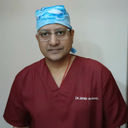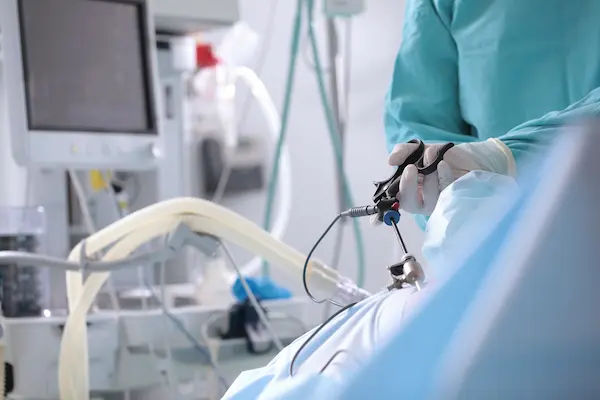Guide to Da Vinci Next Level Technology Surgical Excellence And
Explore the Da Vinci Surgical System, a robotic platform that assists surgeons in complex, minimally invasive operations. Learn the evidence-based benefits—like precision and faster recovery—for procedures in urology, gynaecology, and general surgery.

Written by Dr. Siri Nallapu
Reviewed by Dr. Shaik Abdul Kalam MD (Physician)
Last updated on 27th Oct, 2025

Introduction
If you’ve heard a friend say, “I had a Da Vinci procedure and went home the same day,” you’ve already seen how surgery has moved to a new level. The da Vinci Surgical System (often shortened to “Da Vinci”) is a robotic-assisted platform designed to help surgeons perform complex operations through tiny incisions with remarkable precision and control. For the general public, it can be hard to sift through marketing claims and scientific data to understand when this technology truly adds value—and when a traditional approach might be just as good. In this guide, we’ll cut through the hype and bring you a clear, evidence-aware overview of Da Vinci, what “next-level” really means, and how to decide if it fits your needs. You’ll learn how the system works, which procedures commonly use it, the benefits and limits shown in studies, safety and costs, and what to ask your surgeon. We’ll also share practical tips for pre-op prep and recovery, plus expert insights about where robotic surgery is heading next. By the end, you’ll know how Da Vinci can elevate care—and when a different path may be the right level for you.
Consult a Top Surgeon for Personalised Advice
What is the Da Vinci Surgical System?
It's a robotic-assisted platform that translates a surgeon’s hand movements into precise micro-movements inside the
patient via small incisions.
The da Vinci Surgical System is a robotic-assisted platform designed by Intuitive Surgical to help surgeons perform
minimally invasive procedures through small incisions. It’s not an autonomous robot. Instead, the surgeon sits at a
console, controlling wristed instruments that translate hand and finger movements into precise micro-movements at the
patient’s side. A high-definition 3D camera provides a magnified, immersive view—often called a “next-level” visual
field—so the surgeon can see critical anatomy in fine detail.
Key Components
- Surgical console: Where the surgeon operates, viewing a 3D image and manipulating the controls.
- Patient-side cart: Holds the robotic arms that move instruments and the camera.
- Wristed instruments: EndoWrist tools mimic the dexterity of the human wrist, enabling more natural suturing and
dissection than traditional laparoscopic sticks. - Vision system: Delivers stable, magnified, stereoscopic views to improve precision.
Generations and Meaning
Generations of Da Vinci include Si (earlier), Xi and X (widely used), and SP (single-port), each iteration aiming to take
performance to the next level. For example, the Da Vinci Xi improved arm reach and setup flexibility, while SP fits
multiple instruments through one port to minimise incisions. The right system depends on procedure type and surgeon
preference.
What “robotic-assisted” means—and doesn’t. The robot doesn’t make decisions; the surgeon controls every movement.
The system filters tremor and scales motions, enabling delicate manoeuvres through tiny incisions. This combination
often results in less blood loss, smaller scars, and potentially a quicker recovery compared to open surgery. However, many of these benefits are also achievable with advanced laparoscopy in the hands of an expert team. The best approach is the one that matches your condition, anatomy, and a surgeon’s highest level of skill.
Benefits and Limits: What the Evidence Actually Shows
Evidence suggests benefits in complex cases (compared to open surgery), but advantages over conventional laparoscopy
vary significantly by procedure.
Benefits cited by hospitals and surgeons include enhanced visualisation, improved dexterity, and better ergonomics for
the operating surgeon. For patients, this can translate into smaller incisions, less postoperative pain, reduced blood loss,
and shorter hospital stays in selected procedures compared to open surgery. Multiple large centres report high patient
satisfaction with Da Vinci, and professional societies recognise its role as a next-level tool in complex pelvic and deep
abdominal surgery.
Evidence Caveats by Speciality
- Urology: Robotic-assisted radical prostatectomy has become common worldwide. Studies generally show similar cancer control (surgical margin status) to open or laparoscopic techniques with less blood loss and shorter length of stay, but
longer operating times early in a surgeon’s learning curve. - Gynaecology: For benign hysterectomy, multiple reviews have found similar complication rates between robotic and
laparoscopic approaches, with robotics sometimes taking longer and costing more. The choice often comes down to surgeon expertise and patient-specific factors. - Colorectal: Adoption has grown for rectal cancer and complex pelvic dissections, where stable visualisation and precise pelvic manoeuvres can help. Outcomes may be comparable to laparoscopy; the value proposition often hinges on case complexity and surgeon skill.
Limits Worth Noting
- Learning curve: Achieving “next-level” outcomes depends on training and case volume. Early in a programme,
operative time may be longer and conversion rates higher. - Cost: Robotic systems and instruments are expensive. While shorter hospital stays can offset some costs, overall value
should be assessed for each procedure. - Not universally better: In straightforward cases that an expert can perform laparoscopically, a robot may not improve
outcomes. - Indications: The FDA has cautioned against using robotic-assisted devices for certain cancer surgeries (like
mastectomy) without robust evidence of benefit.
Bottom line: Da Vinci is a powerful platform. The real “next level” arrives when the right patient, the right indication,
and a highly experienced team come together. A transparent discussion about alternatives is essential.
Common Procedures Done with Da Vinci
The system is widely used across specialities like urology, gynaecology, and colorectal surgery, where precision in confined spaces is essential.
Da Vinci is widely used across specialities where precision in confined spaces matters.
Urology
- Prostatectomy (removal of the prostate) is one of the earliest and most common Da Vinci procedures. Robotic
assistance can help with precise dissection near nerves controlling continence and sexual function. Oncologic outcomes
(negative margins) are typically comparable to non-robotic approaches when performed by experienced surgeons, with
less blood loss and shorter hospital stays. - Partial nephrectomy (kidney-sparing surgery) benefits from fine suturing and reconstruction, potentially reducing warm
ischaemia time and preserving kidney function.
Gynaecology
- Hysterectomy for benign conditions and for early-stage cancers is commonly performed with Da Vinci. Robotic
hysterectomy offers stable 3D visualisation for pelvic dissections and complex adhesiolysis; recovery time is generally
similar to laparoscopic hysterectomy, with small incisions and next-level dexterity for suturing in deep pelvis. - Endometriosis excision can be facilitated by enhanced visualisation and fine dissection near nerves and the bowel.
General and Colorectal Surgery
- Hernia repairs (e.g., inguinal, ventral) increasingly use Da Vinci for precise suturing and mesh placement, especially in
complex or recurrent cases. - Colorectal procedures (low anterior resection, rectopexy) benefit from improved access and visualisation in the pelvis;
the choice between robotic and laparoscopic approaches should reflect the surgeon's expertise and patient-specific
anatomy.
Thoracic and Cardiac
- Selected thoracic resections and intracardiac procedures are performed robotically at specialised centres, where next-
level imaging and manipulation may improve access through smaller incisions.
Choosing procedures wisely: Not every operation needs a robot. Ask how Da Vinci specifically helps in your case and
whether your surgeon could achieve the same level of outcome laparoscopically or via a mini-open approach.
Safety, Outcomes, and Quality
Safety is a factor of the system, not just the device, relying on a trained team, appropriate indications, and institutional
protocols.
Safety and quality hinge on three factors: appropriate indication, a trained team, and institutional support. Complication
rates with Da Vinci are generally comparable to laparoscopy and lower than open surgery for many procedures, largely
due to smaller incisions and less bleeding. Conversion (switching to open surgery) is uncommon in experienced hands
but can occur with unexpected bleeding, scarring, or anatomy challenges.
Recovery and Oncologic Outcomes
- Length of stay and recovery: Many Da Vinci procedures are same-day or 1–2 nights in the hospital. Patients often
report less pain and faster return to activities compared to open surgery, though outcomes may mirror advanced
laparoscopy for similar cases. - Cancer outcomes: For prostate and colorectal cancers, margin status and early oncologic outcomes with robotic-
assisted surgery are broadly similar to established approaches when performed by experienced surgeons. Regulators
emphasise that not all cancer indications have proven benefit from robot-assisted techniques; for example, the FDA
issued a 2019 safety communication cautioning against unproven use in certain oncologic surgeries like mastectomy.
Guidance Snapshots
- FDA: Regulates devices and issues safety communications; underscores surgeon training and evidence-based use.
- NICE (UK): Provides procedure- and speciality-specific assessments suggesting where robotics may be appropriate, especially in complex pelvic surgery, while noting cost and training considerations.
- Major centres: Publish patient-friendly risk/benefit summaries and stress the importance of surgeon and team
experience.
Unique Insight: Safety is not solely a feature of the robot; it’s a property of the entire system of care—people, processes,
and technology. Ask about your hospital’s robotic programme, not just the device.
Is It Right for You? Candidacy and Personal Preferences
The best surgical choice depends on your specific diagnosis, anatomy, goals, and your surgeon’s highest competency
technique.
The best surgical approach depends on your anatomy, diagnosis, surgical goals, and your surgeon’s highest competency
technique.
Consider Da Vinci If
- You’re a candidate for minimally invasive surgery, but your case involves deep or complex dissection (e.g., pelvic
surgery, prior adhesions). - Your surgeon has extensive Da Vinci experience and can show centre-level outcomes for your procedure.
- You value the potential for shorter hospital stays, smaller scars, and quicker return to activity.
When Laparoscopy or Open Surgery May Be Better
- Straightforward cases that can be handled efficiently and safely by an expert laparoscopic team with equivalent
outcomes. - When your surgeon’s top-level skill is in another modality, and outcomes are better with that approach.
- Complex redo operations where a hybrid or open strategy offers better control.
Ask about the surgeon's learning curve for robotic surgery; a highly experienced surgeon is key to achieving optimal
results. If your procedure is complex or requires fine dissection, the Da Vinci system may provide a next-level
advantage.
Your Surgical Journey: Before, During, and After
Preparing your body and mind before surgery can enhance recovery, regardless of the surgical approach used.
Before surgery
- Pre-op evaluation: Medical history, medications, and targeted tests (e.g., blood counts, metabolic panel). Optimise
conditions like diabetes or anaemia to reduce risk. - Prep steps: Stop smoking, maintain activity, and follow nutrition guidance. Clarify when to stop blood thinners if
applicable. - Practical planning: Arrange help at home, prepare loose clothing, and set up a comfortable rest space for the first days
post-op. - Labs and screening: Apollo 24|7 offers home collection for common pre-op labs (e.g., CBC, creatinine, HbA1c, vitamin
D), making prep the next level in convenience.
Day of surgery
- Anaesthesia and positioning: Most Da Vinci procedures use general anaesthesia; positioning allows optimal access for
the robotic arms. - The operation: The surgeon controls the Da Vinci console to perform the procedure via small port incisions. Operating
time varies; efficiency increases with team experience. - After the procedure, Many patients go home the same day or after one night. You’ll receive pain control, anti-nausea
medications, and early mobilisation to prevent clots.
Recovery
- Pain and incision care: Expect mild to moderate soreness for a few days. Use prescribed pain plans; many patients
transition quickly to non-opioid options. - Activity: Gentle walking the day of or after surgery is encouraged. Gradually increase activity; avoid heavy lifting until
cleared. - Red flags: Worsening pain, fever, uncontrolled vomiting, chest pain, shortness of breath, or heavy bleeding warrant
immediate medical attention. If your recovery stalls or symptoms persist beyond two weeks, consult a doctor online
with Apollo 24|7 or book a physical visit for evaluation.
Unique tip: Prehab matters. Even 1–2 weeks of walking, breathing exercises, protein-focused meals, and iron
optimisation can make recovery feel more “next-level.”
The Technology Deep Dive
The system’s unique features, such as wristed instruments and Firefly imaging, are designed to enhance the surgeon’s
capabilities.
Da Vinci’s most distinctive features are designed to elevate the surgeon’s capabilities:
- Tremor filtration and motion scaling: Converts large hand movements into tiny, stable instrument actions. This helps
during delicate dissections near nerves and blood vessels. - Wristed instruments: Multiple degrees of freedom mimic the human wrist, enabling precise suturing and knot-tying that
can be difficult with straight laparoscopic tools. - Ergonomics: Surgeons operate seated with head-in console viewing, which can reduce fatigue during long cases—an
often overlooked “next-level” benefit for consistency.
Firefly Fluorescence Imaging (ICG)
- By injecting indocyanine green (ICG), the system’s near-infrared “Firefly” mode highlights blood flow and bile ducts in
real time, helping confirm perfusion of bowel segments or identify biliary anatomy. This can reduce certain
complications and guide safer tissue handling.
Single-Port (SP) and Beyond
- The SP platform allows multiple instruments and camera access through a single incision, often at the umbilicus. It’s
not suited to every procedure, but can reduce the number of incisions. - What’s next: Expect continued advances in vision (augmented overlays), instruments, and possibly decision-support
features. While true autonomy remains distant, incremental steps—like image-guided navigation and workflow analytics—are bringing surgery to the next level of precision and personalisation.
Cost, Coverage, and Value
While robotic surgery may incur higher charges, the value is often realised through shorter hospital stays and quicker
patient recovery.
Costs reflect capital (the robot), maintenance, and disposable instruments. Hospital charges for robotic surgery may be
higher than for laparoscopy, though shorter length of stay and faster recovery can offset some costs from a societal
perspective. Insurance typically covers robotic-assisted procedures if they’re standard of care for your condition;
coverage depends on the procedure, your policy, and local norms.
How to Frame “Value”
- Patient-centred value: Smaller incisions, earlier return to work, and greater comfort may matter to you even if OR time
is longer. - Clinical value: In complex pelvic dissections, next-level visualisation can support safer manoeuvres and lower
conversion rates in experienced hands. - System value: High-volume programmes may achieve efficiencies that narrow cost differences with laparoscopy.
Practical Steps
- Ask the surgeon’s office for an estimate of out-of-pocket costs.
- Check whether your plan differentiates between robotic and laparoscopic codes (often it does not).
- Discuss the expected hospital stay and time away from work—this affects indirect costs.
If you have questions about medical necessity or labs needed for authorisation (e.g., HbA1c, CBC), Apollo 24|7 can
coordinate home sample collection and help you prepare efficiently.
Myths vs Facts (Quick Reality Check)
Understanding the distinction between hype and evidence is crucial for making an informed choice about your surgery.
- Myth: “The robot performs the surgery by itself.”
- Fact: The surgeon is in control 100% of the time. Da Vinci augments dexterity and vision; it doesn’t decide or act
independently. - Myth: “Robotics is always the best and next-level choice.”
- Fact: Many procedures have similar outcomes with laparoscopy. The best approach is the one your surgeon does best
for your specific case. - Myth: “Robotic surgery guarantees less pain and faster recovery.”
- Fact: This is often true compared to open surgery, but differences versus laparoscopy can be small. Individual factors,
pain management, and prehab matter. - Myth: “It’s too new to be safe.”
- Fact: Da Vinci has been used for millions of procedures worldwide over more than two decades. Safety depends on
training, team, and protocols. - Myth: “Cancer results are always better with robotics.”
- Fact: Oncologic outcomes are generally comparable when performed by experts; the FDA cautions against unproven
indications.
Unique insight: Think of Da Vinci as a high-end instrument. A concert violin doesn’t make a beginner sound like a
master; it helps a master perform at the next level
How to Choose a Surgeon and Centre
Selecting a surgeon with high-volume experience and a mature robotic programme is the most critical factor for a
successful outcome.
Selecting the right team may be the most important decision you make.
What to Look For
- Experience and volume: Ask how many Da Vinci cases your surgeon has performed for your specific procedure. Higher
volumes are linked to better outcomes in many surgeries. - Team and programme maturity: Experienced bedside assistants, nursing staff, and anaesthesiologists are part of a next-
level programme. - Transparent outcomes: Complication rates, conversion rates, length of stay, and readmissions should be tracked and
shared when possible. - Breadth of options: A centre that offers robotic, laparoscopic, and open approaches—and helps you choose among
them—puts your goals first.
Conclusion
Robotic-assisted surgery with the da Vinci platform has helped millions of people benefit from minimally invasive
operations that once required large incisions. Its next-level strengths—immersive 3D visualisation, wristed instruments, and motion stability—shine in complex pelvic and deep abdominal procedures, where precision truly matters. Still, the best surgical plan is personal. For straightforward cases, advanced laparoscopy may deliver equal results. For others, Da Vinci can add meaningful advantages that translate to comfort, faster recovery, and smoother hospital experiences—especially in the hands of a seasoned team.
As you weigh options, focus less on the label and more on the fit: your diagnosis, your anatomy, and your surgeon’s top-skill approach. Use the questions and checklists here to guide conversations. If you need help sorting it out, consider a second opinion or a virtual visit. If symptoms persist beyond two weeks or you’re unsure about your recovery, consult a doctor online with Apollo 24|7 for further evaluation. For pre-op labs, Apollo 24|7 offers convenient home collection to keep you on track.
Technology will keep progressing, adding new imaging, single-port options, and smarter tools. But the core remains the same: the best outcomes come from experienced hands using the right tool at the right time—for you.
Consult a Top Surgeon for Personalised Advice
Consult a Top Surgeon for Personalised Advice

Dr. Binay Agarwal
General and Laparoscopic Surgeon
15 Years • MBBS, MS General Surgery
North Dumdum
Dum Dum Medical Centre, North Dumdum
Dr. Deepak G
General Surgeon
2 Years • MBBS, MS
Bengaluru
A.V.S Clinic, Bengaluru

Dr. Deepak Thakur
General Surgeon
10 Years • MBBS, MS General Surgery
Patna
Health Care Clinic, Patna

Dr. Balachandar Kariappa Reddy
General Surgeon
16 Years • MBBS, DNB (Gen. Surg.), FMAS.,FAIS
Chennai
Apollo Hospitals Greams Road, Chennai
(75+ Patients)

Dr Anubhav Chittari
General Surgeon
3 Years • MBBS, M.S GENERAL SURGERY
Bengaluru
PRESTIGE SHANTHINIKETAN - SOCIETY CLINIC, Bengaluru
Consult a Top Surgeon for Personalised Advice

Dr. Binay Agarwal
General and Laparoscopic Surgeon
15 Years • MBBS, MS General Surgery
North Dumdum
Dum Dum Medical Centre, North Dumdum
Dr. Deepak G
General Surgeon
2 Years • MBBS, MS
Bengaluru
A.V.S Clinic, Bengaluru

Dr. Deepak Thakur
General Surgeon
10 Years • MBBS, MS General Surgery
Patna
Health Care Clinic, Patna

Dr. Balachandar Kariappa Reddy
General Surgeon
16 Years • MBBS, DNB (Gen. Surg.), FMAS.,FAIS
Chennai
Apollo Hospitals Greams Road, Chennai
(75+ Patients)

Dr Anubhav Chittari
General Surgeon
3 Years • MBBS, M.S GENERAL SURGERY
Bengaluru
PRESTIGE SHANTHINIKETAN - SOCIETY CLINIC, Bengaluru
More articles from Hernia
Frequently Asked Questions
1) Is Da Vinci robotic surgery always better than laparoscopy?
Not always. For many procedures, outcomes are similar. Da Vinci may offer benefits in complex cases, but the best approach is the one your surgeon performs at the highest level with the safest results.
2) How long is the recovery after a Da Vinci hysterectomy?
Many patients return to light activities in 1–2 weeks and fuller activity by 4–6 weeks, though this varies. Robotic hysterectomy recovery time is often shorter than open surgery and similar to laparoscopy.
3) Is robotic prostatectomy safer than open surgery?
It often involves less blood loss and a shorter hospital stay. Overall complication rates and cancer control can be similar when performed by experienced surgeons. Discuss robotic prostatectomy outcomes with your team.
4) What does Firefly fluorescence imaging do?
With ICG dye, Firefly helps visualise blood flow and bile ducts in real time, guiding safer dissection and confirming tissue perfusion—one reason Da Vinci is considered “next-level” for complex cases.
5) Will my insurance cover Da Vinci surgery?
Most insurers cover robotic-assisted procedures when they are the standard of care for your condition. Ask your provider about robotic surgery cost and insurance coverage specifics for your plan.




